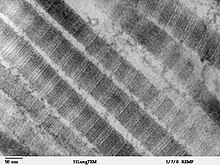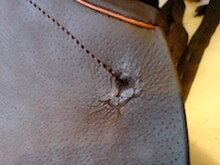Leather care
The leather care refers to procedures to preservation and restoration of leather .
Subdivision
Leather care can be differentiated according to different criteria. In order to reduce soiling, a coating is often applied to modern leathers ( anti-soiling additive , anti-soiling additive).
According to the production method
The various smooth leathers such as B. trimmed leather (surface-coated and -dyed, predominantly closed -pore ), aniline leather (dyed through, open-pored, without finishing), are treated with a leather care product after leather cleaning. Full leather and split leather are treated depending on their surface treatment (aniline leather or prepared leather).
Finished leathers have a surface coating that partially or completely closes the pores of the leather and thus reduces the tendency to soiling (improved soiling behavior ) and also reduces its sensitivity to water. Due to the surface coloring, the color of the undyed, tanned leather underneath can emerge in heavily worn areas, which requires an occasional refreshment of the color of the leather.
Aniline leather does not have a solid surface coating, which is why liquids can partially absorb without a seal and only mild detergents are used for cleaning. A partial pore sealing is achieved with suspensions of hydrophobic polymers , which can be absorbed into the leather and reduce subsequent discoloration. Without a seal, aniline leather forms a patina due to the open pores . Sealing means that aniline leather patina more slowly.
Suede leather is also open-pored and after cleaning is first brushed on with a rubber brush or rubber block and then impregnated.
Patina leather (z. B. at Chesterfield seating ) are provided with an abradable coating of wax in a darker shade and sometimes removed, where the designation wiping leather (engl. Rub-off Leather ) originates. This coating is sensitive to organic solvents such as mineral spirits or alcohol .
After tanning
Chrome-tanned , aldehyde-tanned leather, vegetable- tanned leather and fat-tanned leather can be treated with the usual cleaning and care methods. In alum-tanned leather, the tanning agent is only incorporated into the leather, not covalently bonded, which means that when it comes into contact with water, the alum is released again and the tanning is partially reversed.
According to the origin
While mammalian leather (e.g. from cattle , sheep , goat , pig , deer , horse ) and bird leather (e.g. ostrich ) have similar structural properties and are treated with similar agents, reptile leather (e.g. from snakes , alligators , crocodiles ) and fish leather (z. B. salmon nanai leather , dogfish Shagreen , stingray stingray ) mostly by a chemical cleaning cleaned. Impregnation can be carried out after cleaning . To protect the surface structures of these more sensitive types of leather, cleaning and care products should only be dabbed on and not rubbed on.
After using
When caring for shoes and suitcases made of leather, a surface shine through polishing is often desired, which is why shoe creams that contain solid, polishable waxes are mostly used. For clothing made of leather treatment with is based on a chemical cleaning usually leather grease or impregnation. Furniture leather , automotive leather , bags , belts , purses , riding saddles and leather book covers are finally treated with leather grease after cleaning with mild detergents. After the leather care product has been allowed to take effect (from 10 minutes to several days), excess leather care product is removed in order to avoid staining textiles or paper .
Leather damage
As tanned animal hide, leather consists largely of cross-linked collagen fibers . These protein fibers should be protected from environmental influences such as dirt, moisture and abrasion during leather care. The most common decomposition of leathers are hydrolyses , oxidations , mold fungus , UV light , fat food by fatty acids , red rot (by sulfur dioxide bond formed with humidity sulfur dioxide ), attrition and bending and stretching breakage. In addition, various types of bacon beetles can cause damage to their food.
Because of its polarity, contact with water leads to strong hydration and swelling of the leather. The leather shrinks when it dries, which causes the collagen fibers to rearrange and the leather to become harder. For this reason, leather is drummed after it has come into contact with water to partially restore its suppleness. In the case of untreated colored leathers, contact with water can lead to local diffusion of the dye, which can result in water stains that can only be removed by re-dyeing.
Leather care products
Leather care products fulfill various functions
- Water repellency
- Oxidation protection
- Protection against UV light
- Suppleness and elasticity (moisturizing)
- Change in smell
- Color retention
- Dirt repellent
Typical leather care products are e.g. As shoe polish , leather grease , leather oils or leather care milk ( emulsion with emulsifiers ). These are mostly based on paraffins (similar to Vaseline , but more solid) with other additives. Coating the leather with leather care products reduces the contact with oxygen and water and thus the oxidation and hydrolysis of the leather. Leather care products based on fats of biological origin are also offered. These fats can become rancid and lead to fat eating in the long term. Leather care products also occasionally contain paraffin-soluble substances to reduce oxidation and protect against UV light, e.g. B. propyl gallate , tocopherol or O-phenylenediamine . In addition, fragrances are often added and, in the case of colored leather care products, pigments are also added . In the case of colored leathers, due to the patination of the leather that darkens over time, a color shade of the care product is usually chosen that is slightly lighter than the color of the leather.
Shoe polishes
In addition to paraffins, shoe creams, shoe waxes and pomades also contain waxes for a higher gloss after polishing and a higher resistance to abrasion. Since the 1990s, beeswax and carnauba wax have also been added in response to increasing customer requests. The natural waxes have a lower strength than hard waxes and lead to increased static friction and thus to an increased stick-slip effect and stronger creaking when leather surfaces rub against one another.
Leather grease
Leather fats are often less viscous than shoe polish in order to be able to penetrate deeper into the leather and to create a softer feel .
Impregnating agent
An impregnation agent mostly consists of paraffin with solvents , which is used in aerosols . There are also impregnating agents based on silicone oil ( silicone sprays ) and fluorocarbons ( Teflon sprays ).
Leather cleaning
Before leather care is taken, the leather is usually cleaned to prevent dirt from being worked into the leather during leather care. The gentlest leather cleaning processes are the PER process (with perchlorethylene ) and the KWL process (with hydrocarbon solvents ), which are offered by professional cleaning companies due to the technical effort required to recover the organic solvents used. The use of organic solvents can attack plastic components in a leather-plastic composite material. The material authenticity is therefore checked in an inconspicuous place by dripping the solvent on an internal (not directly visible) point of the plastic part and wiping it off and inspecting it after about one minute. The non-polar organic solvents ( KWL and PER ) are used in leather cleaning, since compared to aqueous solvents there is little swelling and shrinking of the leather and the fats from the user's skin are extracted again.
For home use, leather is first freed from adhering dirt and dust with a soft brush . With a cloth moistened with a little water , water-soluble components such as salts and other polar substances (soil, food) can be removed. The leather is then cleaned with a water-based cleaning agent. Mild surfactants such as long-chain fatty alcohols (e.g. cetyl alcohol or stearyl alcohol ) or nonionic surfactants are usually used as aqueous leather cleaning agents, and saddle soap is also used for less sensitive leathers that are not tanned in the acidic pH range . Avoid soaking the leather when cleaning leather because of swelling and shrinking. The cleaning agents are then removed with a cloth moistened with a little water so that they do not accumulate in the leather. This results in better soiling behavior of the leather in the long term, since soiling can more easily be absorbed into the leather in the presence of surfactants. Short-chain alcohols such as ethanol can denature the proteins in the leather , especially in higher concentrations (e.g. alcohol ) , which can damage the surface of leathers without finishing (e.g. aniline leather, suede).
literature
- Fritz Stather : Gerbereichemie und Gernahmechnologie , 4th edition, Akademie Verlag, Berlin 1967.
- Axel Himer, Kim Himer: The big book of leather care: Shoe care - clothing - furniture care , 2011, Heel. ISBN 978-3-86852-458-1 .
Web links
- Knowledge about housekeeping . Retrieved March 12, 2013.
Individual evidence
- ^ John Lobb : How to take good care of your shoes , 2013, Peninsula Press. (Brochure, English).
- ↑ H. Schulz: High-quality, natural upholstery leather with high fastness properties and low emissions , Research Institute for Leather and Plastic Sheets (FILK). Retrieved March 12, 2013.


